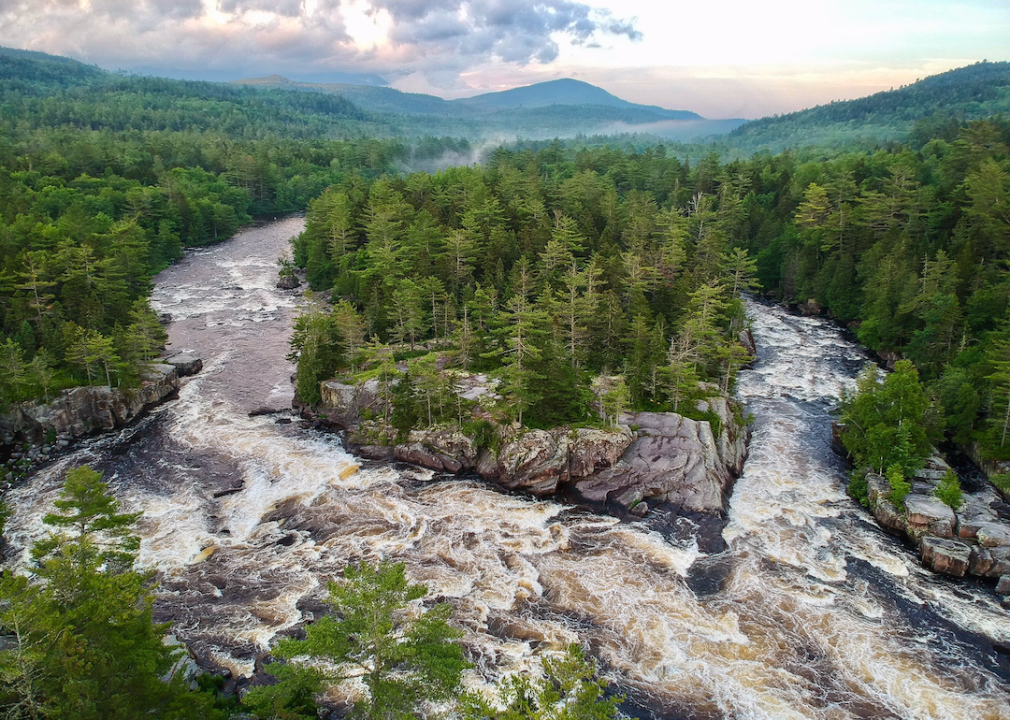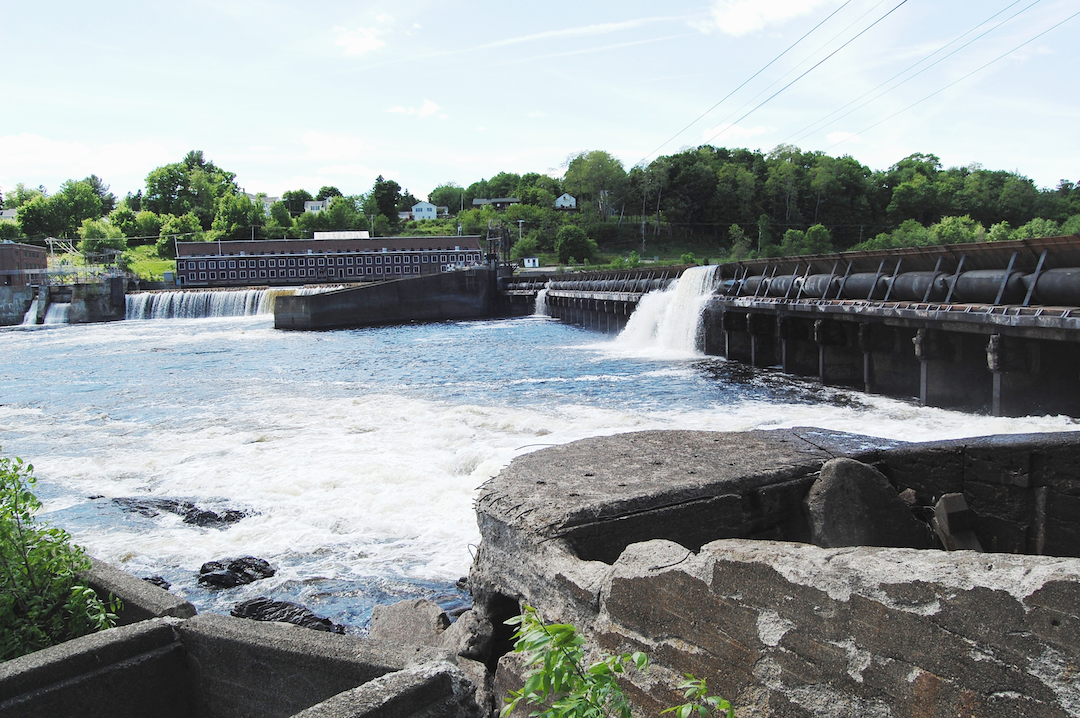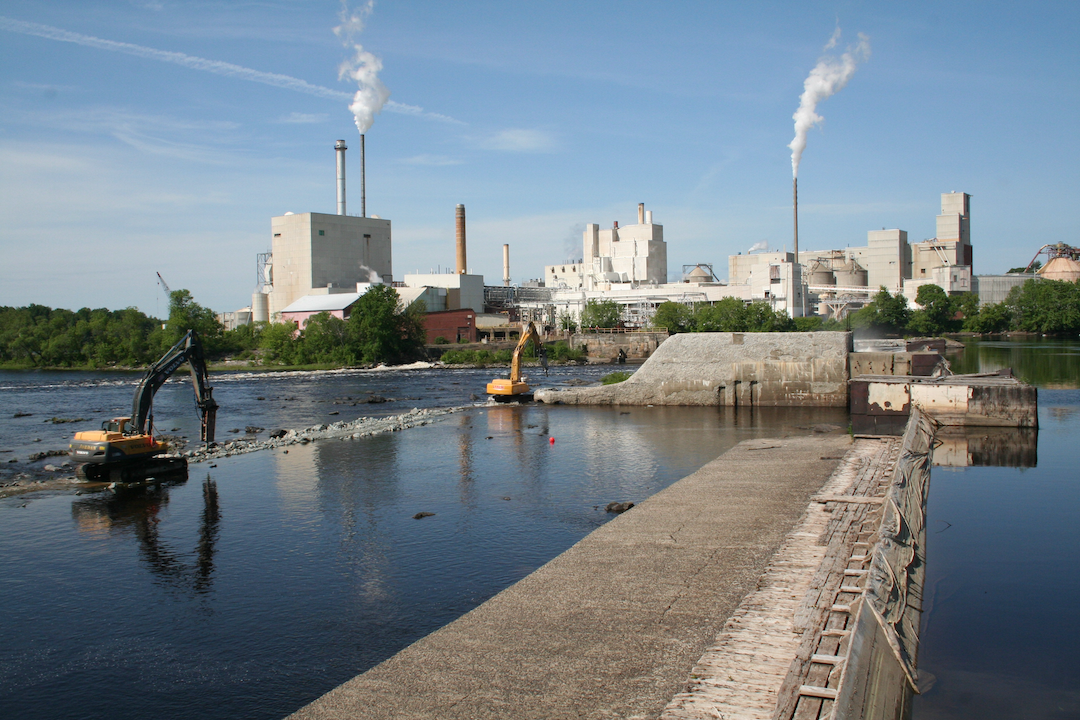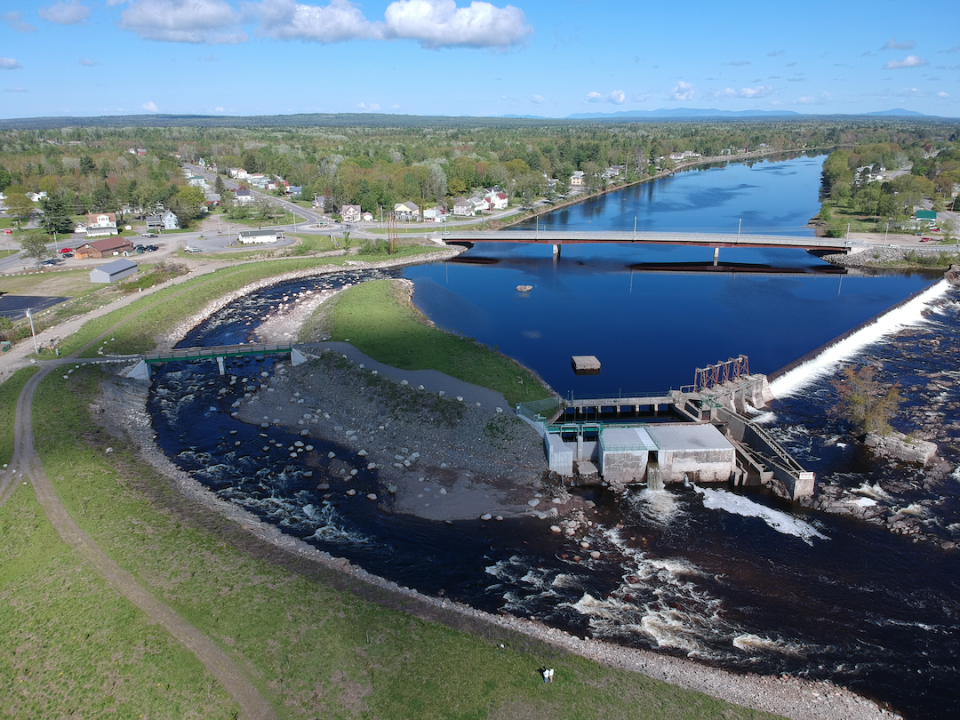'Take it down and they'll return': The stunning revival of the Penobscot River

About a week before the removal of the Great Works Dam on the Penobscot River in Old Town, Maine, Dan Kusnierz dragged his sons to the riverside to take their picture in front of the aging structure. They had just come from a little league game. "They were being goofy and didn't understand it," Kusnierz, the water resources program manager for the Penobscot Indian Nation, recalls. It was 2012, and with the dam's removal imminent, the river — New England's second-largest — was about to transform.
For nearly two centuries, the Penobscot had been choked with logs and pulp as the timber and paper industries — both long-standing cornerstones of Maine's economy — used it both as a lumber byway and waste receptacle. From just 1830 to 1880, more than 8 billion feet of timber floated down the river. To power all this industry, dams were erected, 119 in the Penobscot River Basin alone. Two in particular, the Great Works and the Veazie, posed an outsized threat to the river's health.
Perhaps irrelevant to his children posing for a picture at the time, Kusnierz, who is not Penobscot but has served the Nation for 20 years, was one the members of an unprecedented coalition of scientists, Indigenous people, and conservationists working to remove both dams in order to free the Penobscot River and hopefully restore its health in the process.
The river had been sick for generations. Butch Phillips, a Penobscot Nation elder, recalls growing up on Indian Island, the Penobscot tribe reservation located near Old Town on the river, in the 1950s. By that time, the Penobscot was unrecognizable to the body of water it had once been, with drifting logs so gridlocked at times on the eastern side of the island that the river was impassable for boats and people alike. This posed an ongoing dilemma for the Penobscot people who, prior to the construction of a bridge in 1950, used canoes to travel to and from the mainland.
Despite the discharge coming from the mills, the river was still central to the Penobscot Nation's everyday life. "[The river] was our playground," Phillips told Reasons to Be Cheerful. "We were either canoeing on it, fishing, swimming in it, and in the wintertime we were skating on it." But the relationship had been affected. Living so closely with a body of water like the Penobscot for so many generations, he explains, "you develop a river culture. We are river people, we're canoe people. And when you take away that element, that river and the use of the river, then you take away the culture as well."
One of the worst blows to the river, though, was to its 12 species of sea-run fish. The Great Works, Veazie, and Howland dams, all built in the 19th century, severed access to the river's headwaters, which fish like alewives and shad, shortnose sturgeon, and Atlantic salmon used as spawning ground. When the dams were erected, the effects on the fish population were almost immediate: By the 1850s, salmon no longer inhabited most of the rivers in southern Maine and their populations continued to decline so dramatically that in 1889, the U.S. government opened the Craig Brook National Fish Hatchery in Orland, Maine, to support the besieged fish. For the next 50 years, it was the primary source of salmon eggs for the region.
Yet salmon numbers continued to decline. By 1948, the final year of the commercial fishing industry for wild Atlantic salmon, only 40 were reported caught in the Penobscot watershed. In the late 1980s, around 2,000 salmon made it to the Veazie Dam (the first dam fish returning from the ocean encounter on the river), a number drastically whittled down from the species' original population of about 200,000 annually. In 2009, wild Atlantic salmon were added to the endangered species list.


A river in crisis
Photo: The Veazie Dam before removal.
These were the stakes when the dams' licenses were up for renewal in 1998, and leaders of the Penobscot Nation saw an opportunity to make a significant change to the status quo. The tribe's plan was to purchase the dams — and then destroy them. So they joined with the Atlantic Salmon Federation to open a dialogue with the dam owner, a company called PPL Maine, to buy them. The cohort gathered more participants — American Rivers, the Natural Resources Council of Maine, and Trout Unlimited — and formed an alliance called the Penobscot River Restoration Trust.
The river was in crisis: In addition to the dwindling salmon population, only two alewives were counted at the Veazie Dam in 2010 (NOAA estimates historically the river had 14 to 20 million), arguably one of its most alarming health indicators yet. Alewives, a type of river herring native to the Penobscot, feed just about everything and everyone, from the bottom of the food chain up. With no alewives, there would be no otters or fishers or osprey or eagles.
"The impacts of a dam are especially local," says Laura Rose Day, executive director of the Penobscot River Restoration Trust. So while the Trust engaged in years-long negotiations with PPL, community outreach became an equally key component to the project's success. Rose Day, along with Cheryl Daigle, an outreach coordinator for the project, and Butch Phillips, who was tapped as an ambassador for the Penobscot people, set out on a lengthy effort to share the good news of the project with the community. Individually, they logged hours of knocking on doors, maintaining tables and booths at sports shows, hosting the Penobscot River Revival Festival and just persistently showing up for people who came to them with questions and concerns.
It wasn't always easy to find receptive minds. "In the broadest sense, change is an obstacle," Molly Payne Wynne, the project's monitoring coordinator and project associate, explains. "You're essentially coming into a community, and you're asking that the one thing that they see every day, or the one constant that they know — this structure in the river — you want to remove that and totally change the visual and what that means for them."
"The key to all of these projects is finding the right equation to meet public and business and Indigenous and other rights and interests and needs, based on the place," Rose Day reflects. Daigle says she often found herself translating the science of the project for people and also managing the varying perspectives of how a river should be: "Part of it is not being afraid to venture into that territory where there's conflicting views about use of a resource."
For his part, Phillips discovered that there was a dearth of knowledge community-wide when it came to the tribe's relationship to the river. "My ancestors have been on this river for literally thousands of years," he notes. "And that connection goes really deep because through those many, many generations, the people depended on the river and the surrounding land for their everyday living: Their food, their shelter, their weapons, their transportation, clothing, everything came from the river and the land."
Phillips felt it was crucial to add that perspective to the project. "I was talking about the connection of Penobscot to the river and the fish and all the creatures, and to many of those listening, it was the first time they heard it," he says.
Daigle's experience reflected a similar revelation: that communicating the science was important but, perhaps, what mattered more were small moments of communion that involved the river itself. After the dams were purchased, as some of their impoundments were being let out, there was an effort to move the river's freshwater mussels to safety. For several weeks, Daigle, along with close to seventy volunteers, waded through the waters of Penobscot, moving the mollusks out of harm's way. "It was sort of this intimate act to move these mussels, and build a little sense of community around that," Daigle recalls.

As dams were removed, the return of marine life was swift
Photo: The Great Works Dam mid-removal.
The project was unprecedented in its ambition and its success. The Trust ultimately raised $60 million to purchase the Veazie, Great Works and Howland dams in 2008. In 2012, the Great Works Dam was the first to go, followed by the Veazie in 2013. The Trust was unable to convince the community of Howland to remove its dam, and so a compromise was reached in which a fish bypass was added to the dam to allow an open route for returning fish. As a result, nearly 2,000 miles of habitat was opened for salmon and other species.
In the nine years it took to come to an agreement with PPL, which included generating more power at alternate dams so there wouldn't be a decrease in hydroelectricity, scientists were able to seize the opportunity to really study the river, and what happens to one before and after dam removal.
When you dam a river, it's like flooding a house. Water pools and settles, as does sediment, and what you get is a warm, still environment, nothing like the lively, textured existence of a flowing river. But when you remove a dam, the river's rebound is robust and swift. In 2018, just six years after the removal of the first dam, more than 2 million river herring (which includes alewives) were counted passing through a local fish lift in addition to 772 salmon. "When we do on-the-ground restoration actions with these fish, they respond immediately," says Payne Wynne. "It's fascinating. And it's unique in the restoration world, because in other spheres of restoration, it can take decades to see any real response to the actual, immediate restoration activity."
The degree of the project's success — the river's surprising return — has bolstered hope that future efforts like it will only continue to improve the outlook for Atlantic salmon and other fish species. Though the Trust has since dissolved, work continues to remove dams further upstream along the Penobscot's many tributaries, which would open up more cold-water spawning habitat to all the sea-run fish. But as the nearly 15-year effort of the Trust demonstrates, dam removals are arduous, persisting battles. A win is not to be taken for granted.
In contrast to the river herring, the salmon population's recovery has been more modest, with around 1,500 returning to the Penobscot this year — the most since 2011 but still just a slight 10-year increase. "It's a really hostile environment for Atlantic salmon in the North Atlantic right now," says Rory Saunders, NOAA Fisheries' Downeast coastal salmon recovery coordinator, referring to the challenges posed by climate change. "The Penobscot run in particular is almost entirely dependent on the hatchery at this point."

A river free-flowing
Photo: The Howland Dam bypass enables fish to pass safely through.
At the hatchery in the fall of 2023, 250 mature females prepared to spawn, their dappled bodies taut with eggs. The fish had migrated to the likes of Newfoundland and back, and now they swam lazily in their tank, a sign of late pregnancy. I stood in the tank observing the Fish and Wildlife techs as they scooped each female gently up in a net — taking hold of her tail and lifting her delicately, always supporting her head — for the inspection of a biologist.
The fish weren't quite ready to spawn, but they were getting there, and learning this distinction took years of experience, of plucking expectant females from tanks and pinching their bellies, of discerning the difference between the feeling of a ziplock baggy full with water and one that's bursting. These fish would need another week. Then the techs would do it all again—scoop, pluck, pinch.
Once the females spawned, the eggs would be fertilized and incubated, and eventually some would be placed in man-made salmon redds, tiny depressions made in the sand normally by the wiggle and swoop a female's body, through a hole drilled in ice. This is the ritual—tender and technical—of saving the last wild Atlantic salmon on the planet.
"The Penobscot project is a tremendous first step, but it's not a silver bullet. We need to continue to think about upstream habitat," acknowledges Saunders. There are hopes to remove more dams along the Piscataquis River, a tributary to the Penobscot, which would allow for access to more good, cold water for the salmon, but this could take years.
Still, there is much to celebrate. "We went from 2,000 animals to five million animals in the span of 12 years. That's as good-news-story as you see in ecology, as you see in natural resources," says Saunders. The return of the salmon holds significance to the Penobscot Nation as well. "It's not just the fish," explains Kusnierz. "It's restoring a huge part of the culture of the tribe. Those are their relatives that have long been gone and are here again. That's what the vision of the tribe was in those negotiations. [It] was kind of the opposite of 'build it, and they will come.' It was 'take it down and they'll return.'"
In the tradition of the Penobscot Nation, Phillips has collaborated on the construction of two different birch bark canoes and in one instance, took the boat up the Penobscot toward Mount Katahdin, toward the headwaters. Phillips, along with other community members including one of his sons, was retracing the path of generations before him — up the river and toward the mountain, which never seemed to disappear from view despite the constant bend and curve in the water's trajectory.
At one point, after a particularly tough paddle through an ancient waterway on the west side of the river, Phillips turned to his son. "I told him, Let's stop, and we laid on the ground," he recalls. The moment was one of providence: "We're walking in the same footsteps as our ancestors have for thousands of years." This was in 2002, prior to the removal of the dams, and the group had to maneuver the canoe around them on their journey. The restoration project was in its nascent stages then, and the hope to someday see the river healthy and unrestricted still seemed like a moonshot, even to Phillips.
"I'm just so happy that I lived long enough to see at least a portion of our river free-flowing, so that the sea-run fish can ascend the river and go to their ancestral spawning ground as they did before the dams went up," says Phillips. "As my ancestors witnessed."
This story was produced by Reasons to be Cheerful and reviewed and distributed by Stacker Media.
